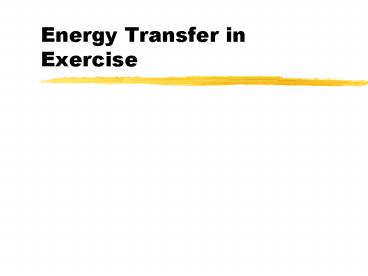Energy Transfer in Exercise - PowerPoint PPT Presentation
1 / 21
Title:
Energy Transfer in Exercise
Description:
With progressively demanding aerobic exercise, region where O2 uptake plateaus ... Lactate removal is accelerated by aerobic exercise ... – PowerPoint PPT presentation
Number of Views:311
Avg rating:3.0/5.0
Title: Energy Transfer in Exercise
1
Energy Transfer in Exercise
2
Immediate Energy
- ATP-CP stored in muscle
- sprints
- heavy weightlifting
- events lt 10-15 seconds
3
Short-Term Energy
- Lactic Acid
- Anaerobic Glycolysis ? LA
- Intermediate energy source
- Maximal intensity for 60-180 seconds
- 400 meter run
- 100 meter swim
4
Blood Lactate Concentration
Untrained Threshold
Untrained
Trained
Trained Threshold
5
Factors Related to Lactate Threshold
- Low tissue O2 (hypoxia)
- Dependence on glycolysis
- Activation of FT muscle fibers
- Reduced ability to remove lactate
6
Training the Lactate Threshold
- Training can ? threshold by 20-30
- genetics
- training effect of producing less LA
- training effect of more efficient LA removal
7
Long-Term Energy
Oxygen Uptake (ml / kg-min)
8
Steady State/Rate
- Initiation of Exercise
- O2 uptake rises exponentially
- Plateau is reached between 3-4 minutes
9
Oxygen Deficit
- Quantity of O2 that would have been consumed had
steady state been reach immediately
10
Oxygen Deficit
- Endurance training ? reach steady-state sooner ?
total O2 consumption is ? ? ? anaerobic component
11
VO2max
- With progressively demanding aerobic exercise,
region where O2 uptake plateaus - Represents an individuals capacity for aerobic
resynthesis of ATP - Helps determine ones ability to sustain high
intensity exercise for longer than 4-5 minutes
12
Energy Spectrum
13
Energy Spectrum
100
Percent of Total Energy Yield
50
60
10
30
Maximal Exercise Time (minutes)
14
O2 Dept
O2 requirement
O2 deficit
O2 Dept
O2 Consumption
Steady-state O2 consumption
Resting O2 consumption
Start Exercise
End Exercise
End Recovery
Exercise Time
15
Classic O2 Dept (EPOC) Theory
- Fast component represents O2 required to
rebuild ATP and CP - Slow component removal of tissue lactate via
conversion to glycogen or oxidation to CO2 and H2O
16
Contemporary EPOC Theory
- Short duration, light to moderate exercise ?
- Recovery O2 serves to replenish high-energy
phosphates (several minutes
17
Contemporary EPOC Theory
- Longer duration, high intensity aerobic exercise
? - Much longer period of O2 uptake
- Some used for lactate ? glycogen
18
Causes of EPOC following Heavy Exercise
- Resynthesize ATP and CP
- Resynthesize lactate to glycogen
- Oxidate lactate in energy metabolism
- Restore O2 to blood
- Thermogenic effects of elevated core temp.
- Thermogenic effects of hormones
- Effects of ? HR, ventilation, other functions.
19
Recovery
- Steady state aerobic exercise or 5 to 10 second
bouts of maximal exercise ? not lactate
accumulation ? recovery is rapid - Fast component
20
Recovery
- Longer periods of anaerobic exercise ?
- Lactate accumulation
- Fast and slow components
21
Recovery
- Exercise at 50 of VO2max can be continued at
steady-state w/o build up - At 60-75 of VO2max no steady-state ? lactate
accumulates - Lactate removal is accelerated by aerobic exercise































